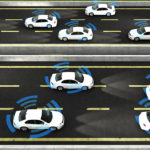Drones, robots and self-driving cars were buzzing through downtown Westminster on Thursday for the ribbon-cutting of the first phase of MAGIC’s autonomous corridor project.
MAGIC, which stands for Mid-Atlantic Gigabit Innovation Collaboratory, is a technology nonprofit in Carroll County and it has a plan to improve transportation downtown. MAGIC is working with Dynamic Dimensions Technologies, or DDT, to scan routes so autonomous shuttles can operate on a circuit and transport residents from place to place.
Graham Dodge, the executive director of MAGIC, said in a November interview the vehicles will have sensors that will help avoid obstacles in roads and adjust to formats like traffic circles. Its programming will allow the shuttle to understand the city’s format and it will continuously scan the layout.
Dodge said in a phone interview that this is the beginning of what will “hopefully be no longer than a two-year project.”
The plan is to scan an 11-mile corridor then virtually test the various technologies that would allow the vehicles to drive themselves.
MAGIC hosted an event to kick-off phase one of the project at the Stockdale’s Service Center. Before the ribbon cutting, a few speakers gave their take on the project.
First to speak was Kelly Schulz, secretary of Maryland Department of Commerce, who said the autonomous corridor project is “an example of a bold new idea,” creates partnerships and makes transportation equitable.
Julia Jasken, the soon-to-be president of McDaniel College, said transportation has historically been a challenge for McDaniel students. This project could help with that.
The route would connect the retirement community Carroll Lutheran Village to McDaniel College and to Main Street in Westminster, then on to Carroll Community College and the YMCA.
Libby Trostle, Carroll Community College’s vice president of continuing education and training, spoke to the possible partnership with MAGIC and Mona Becker, mayor of Westminster said the project would not have been possible without the city’s fiber network.
She added Westminster is a city that innovates and chases technology, not one that waits for it to happen.
Around the parking lot were several tents belonging to the local colleges but also companies like Ting and the nonprofit Together We Own It. Towards the back were the likes of FIRST (For Inspiration and Recognition of Science and Technology), with its remote-controlled robots.
On the other side of the garage were members of Perrone Robotics, letting the public go for a ride in its self-driving van. It seated about 10 people. The driver drove the van manually from the garage near East Middle and allowed the car to drive itself on Willis Street.
“We’re not going that fast, I promise,” Colleen Hahn, vice president of marketing and communications for Perrone Robotics, said before the van took off.
She said the vehicle has gone through a checklist of safety measures and has driven on multiple public roads. The van had a normal steering wheel and driver seat where Kyle Hernandez, a test/quality engineer for Perrone, was sitting. He took his hands off the wheel but kept them close as the van went into autonomous mode. It turned by itself and even went through a four-way traffic stop on its own.
Hahn said in the previous test drive, it stopped for a black cat that walked in the street near a funeral home.
Becker said the ride was cool and was impressed by how smoothly it navigated the turns in the road and with the four-way stop. Dan Hoff, a member of Westminster’s Common Council, called it awesome and said it makes him wonder what Westminster will look like in 10 years.
Dodge said he hopes there will be a mix of different vehicles on the corridor, including Perrone, which could be owned by the city or other entities. He said FedEx, for example, could use the corridor for its autonomous robots to deliver packages.
He said the next steps will be virtual assessments like seeing if an autonomous vehicle can make it up a hill, which he hopes can be done by the fall.
Topics Maryland
Was this article valuable?
Here are more articles you may enjoy.


 AIG Announces Strategic Investment Partnership of Up to $3.5B With CVC
AIG Announces Strategic Investment Partnership of Up to $3.5B With CVC  Thumbs Down on SELF DRIVE Act as Written, Says Industry Trades
Thumbs Down on SELF DRIVE Act as Written, Says Industry Trades  Florida OIR Triples the Size of Citizens’ Rate Decrease
Florida OIR Triples the Size of Citizens’ Rate Decrease  10,000 Travelers Employees Get AI Assistants Via Anthropic Partnership
10,000 Travelers Employees Get AI Assistants Via Anthropic Partnership 

